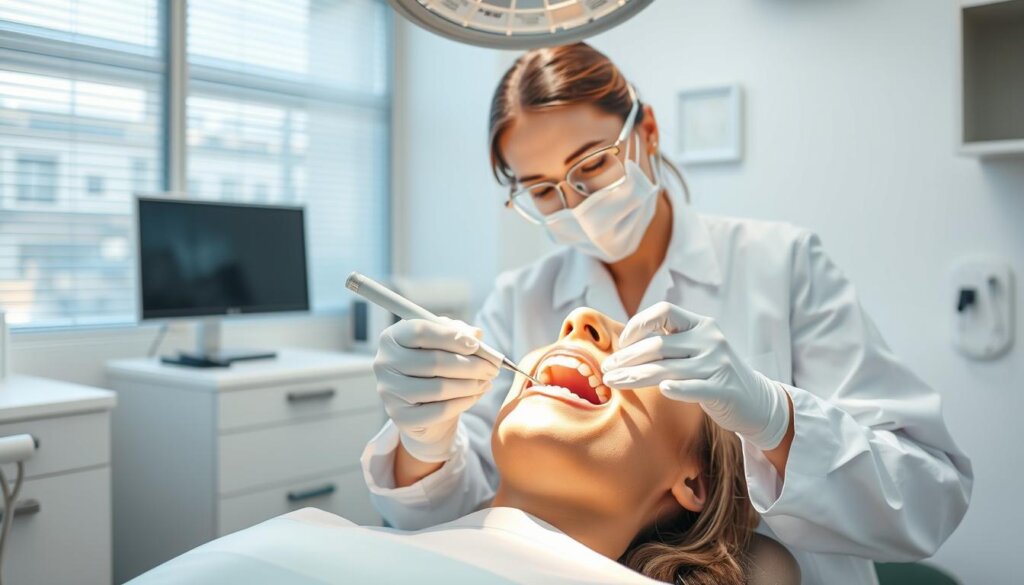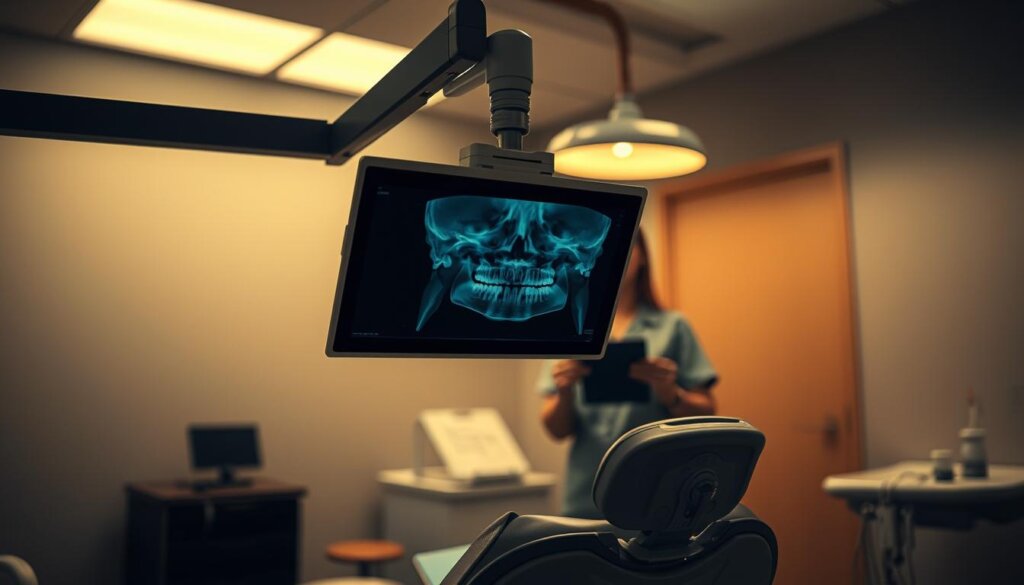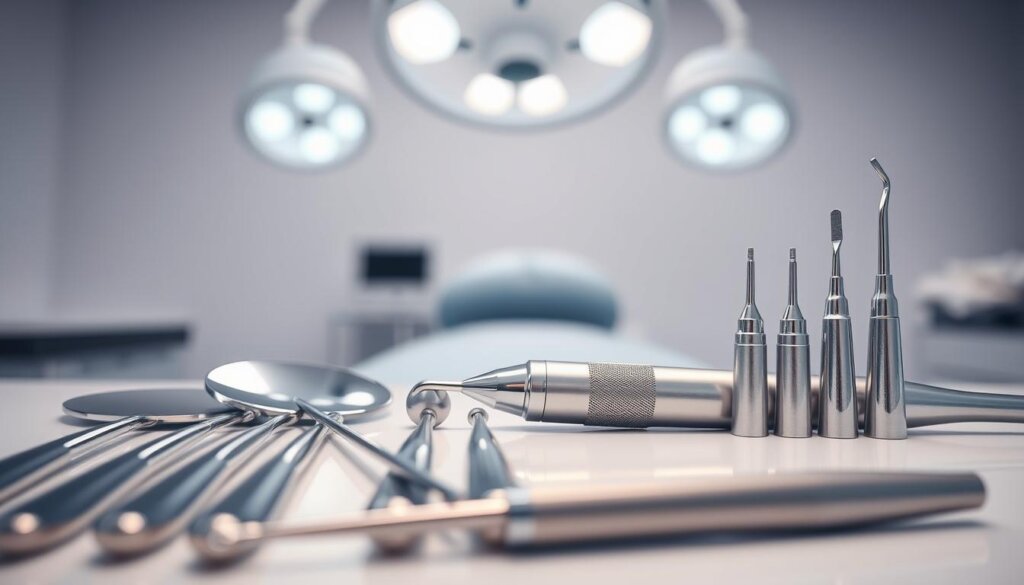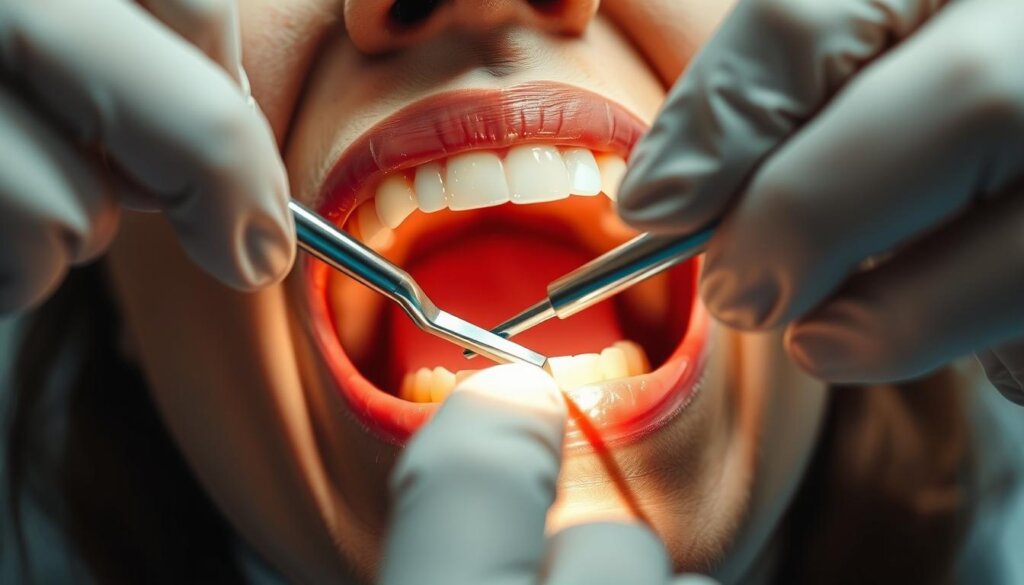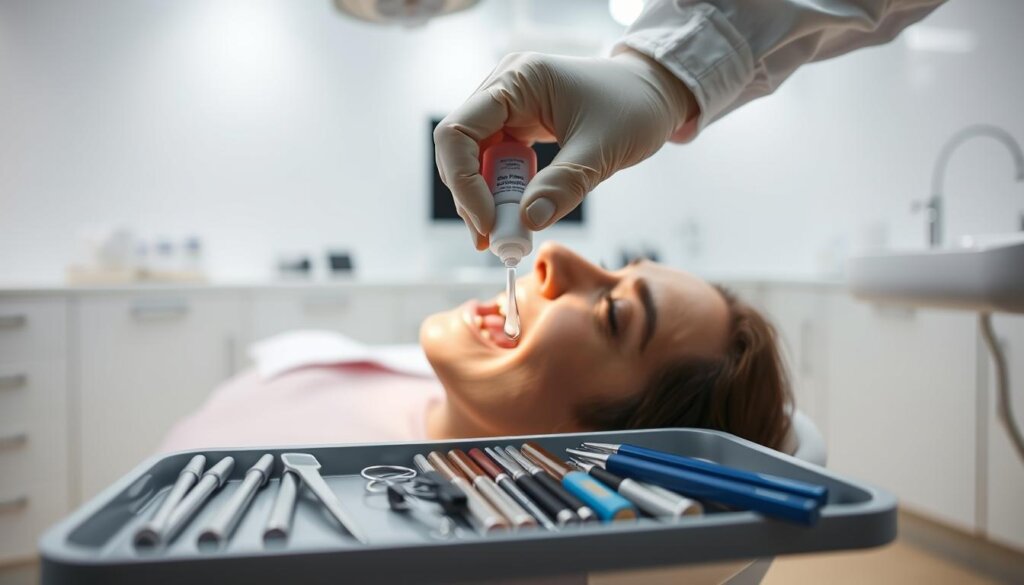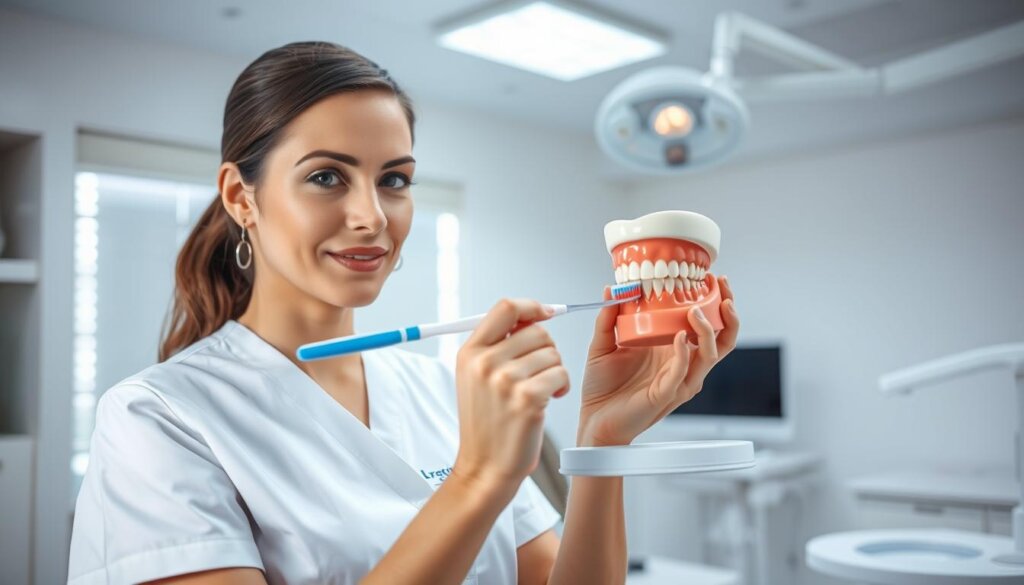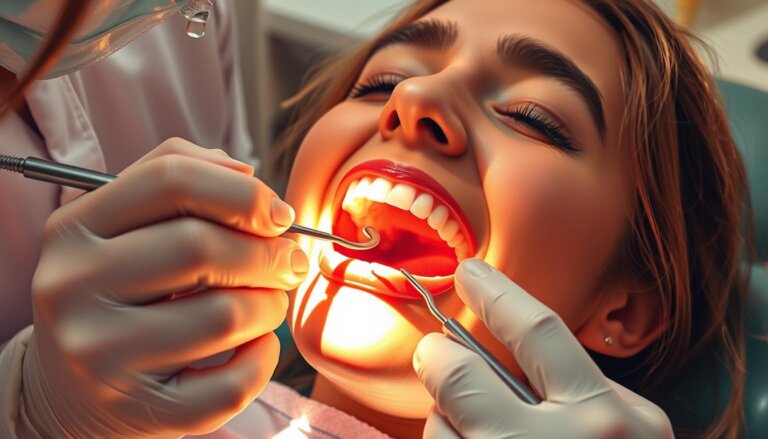What Happens During a Dental Check-Up and Cleaning?
Every year, people in the United States spend billions on dental care. Yet, many don’t know what happens during a check-up and cleaning. These visits are key to keeping your mouth healthy and avoiding more expensive dental work later. Knowing what goes on during these visits shows how important they are for your overall health. Everything starts with a full check of your oral health by a pro.
The check-up begins with a dental hygienist looking closely at your mouth. Using a small mirror, they check each section for signs of problems like swelling or gingivitis. They then clean off plaque and tartar in hard-to-reach spots, using a tool called a scaler.
After that, your teeth get polished with a special toothpaste. A thorough flossing follows, making sure no plaque or bits of food are left behind. To wrap up, you get a refreshing rinse and a fluoride treatment. This treatment helps prevent cavities. If needed, you might also get dental X-rays. These X-rays give a complete picture of your mouth’s health, spotting any hidden issues early.
Key Takeaways
- Understanding what happens during a dental check-up makes us value its role in our oral health more.
- The initial assessment helps find problems that we might not notice ourselves.
- Getting rid of plaque and tartar helps stop gum disease and other dental problems before they start.
- Professional cleanings reach places daily brushing and flossing might miss.
- Fluoride treatments and X-rays are crucial for preventing cavities and finding hidden issues.
- All these steps are important for keeping our mouth healthy, which affects our overall health too.
Importance of Regular Dental Check-Ups
Understanding how crucial regular dental visits are for keeping a healthy mouth is important. These appointments involve more than just cleaning. They include dental hygienist services, cavity detection methods, and a gum health evaluation. All these things are key in stopping oral diseases before they can get worse.
The main goal of preventative dental care is stopping problems before they start. Regular check-ups help find and manage oral health issues early. This can prevent them from becoming serious problems. Let’s dive deeper into how these visits can save on costs and benefit health over time:
Benefits for Oral Health
- Regular gum health evaluations help avoid gum diseases from developing.
- Using modern cavity detection methods helps spot and treat issues early, saving teeth.
- Professional cleanings from dental hygienists keep your mouth healthy and stop plaque buildup.
Long-Term Cost Savings
- Spotting problems early can cut down on the need for bigger, more expensive treatments later.
- Consistent care from dental hygienist services makes natural teeth last longer, reducing the need for replacements.
- Preventative actions like cleanings and fluoride treatments significantly lower the chance of dental emergencies.
Preventive Care and Early Detection
Preventative care is essential in regular dental visits. Catching issues early means dentists can fix them more simply and affordably.
| Preventive Measure | Health Impact | Cost Benefit |
|---|---|---|
| Regular Cleanings | Decreases incidence of cavities and gum disease | Reduces long-term treatment costs |
| Comprehensive Exams | Early detection of oral health issues | Prevents costly advanced treatments |
| Gum Health Checks | Identifies early signs of periodontal issues | Limits the need for surgical interventions |
Choosing regular dental check-ups is a smart health move. These visits allow experts to check your oral health in many ways. This ensures benefits that help both now and in the long run.
What to Expect Before a Dental Check-Up
Getting ready for a dental exam involves several steps to ensure it goes smoothly. Knowing what these steps are can ease worries. It makes the appointment more comfortable and efficient.
First, pick a time for your appointment that fits well with your day. It’s key to not feel rushed. This helps you to be calm and punctual for your visit.
Preparing for the Visit
Before your appointment, confirm it a day ahead and arrive early. This helps avoid any hurry. It also gives you time to relax before the exam starts. Bringing your ID, insurance info, and any filled-out forms can save time.
Medical History and Health Considerations
It’s vital to give a full and correct medical history. Include your medications, past surgeries, and allergies. This info guides your dentist’s approach to your exam. Talking about your health history helps avoid problems and customizes your care.
| Checklist Item | Reason |
|---|---|
| Confirm Appointment | To ensure the scheduled time and date are correct and to avoid miscommunications. |
| Arrive Early | Allows for a relaxed start to the appointment without rushing. |
| Bring Necessary Documents | Ensures all required information is available for review to facilitate a smooth appointment process. |
| Update Medical History | Provides the dentist with the necessary information to tailor the dental treatments according to health considerations. |
Your dental care team is there to support your oral health. Being ready helps you get the most from your exam. It leads to better dental health outcomes.
The Initial Assessment Process
When you go to the dentist for a check-up, the first assessment is very important. It starts with a careful look at your teeth and gums. Then, you might need dental X-rays. Lastly, the dentist will check your gum health.
This whole process helps find any early signs of mouth problems. It makes sure your mouth stays healthy.
- Visual Examination by the Dentist
- X-Rays: When and Why They Are Needed
- Assessing Gum Health
The first thing the dentist does is a detailed look at your mouth. They check your gums, teeth, and even your throat and neck. This look helps find any signs of problems that need more tests or quick treatment.
Dental X-rays during check-up are a key part of checking your dental health. They are usually done once a year. X-rays can show hidden issues, like under the gums or inside the jawbone. They help the dentist make a good plan for your treatment.
After X-rays, the dentist checks your gums. This step is important for keeping your teeth strong. Checking gums helps find gum disease or swelling. This is important because bad gums can lead to other health issues.
This careful method makes sure your dentist fixes any current problems. It also prevents new ones, keeping your mouth healthy.
The Cleaning Process Explained
The first step in getting your teeth cleaned is a detailed check-up by a dental hygienist. They use special tools to clean your teeth. These tools get rid of plaque and tartar, especially where regular brushing can’t reach.
| Tool | Function | Importance in Cleaning |
|---|---|---|
| Scaler | Removal of tartar (calcified plaque) from teeth surfaces. | Essential for preventing gum disease and tooth decay. |
| Small mirror | Enables the hygienist to view hard-to-reach areas. | Critical for thorough examination and cleaning. |
| Polisher | Smooths teeth surfaces after tartar removal. | Helps in stain removal and gives teeth a shiny finish. |
Each tool has a key role in cleaning your teeth well. They help make sure every part of your teeth is clean. These tools not only make the cleaning better but also keep your mouth healthy. Thanks to new dental technology, hygienists can take even better care of your teeth now.
These cleanings do more than make your teeth look nice. They remove harmful plaque and tartar, especially below your gums. This helps prevent gum disease and keeps your teeth healthy. Getting your teeth cleaned by a professional regularly is important for your mouth’s health.
The Role of Dental Instrumentation
Dental professionals use special tools and techniques in routine check-ups to keep your mouth healthy. Scaling and root planing are key in fighting gum disease by removing plaque and tartar. These methods not only treat gum issues but also prevent them, helping teeth last longer.
Scaling and Root Planing
Scaling and root planing deep clean your gums, done by expert dental hygienists. First, scaling gets rid of plaque and tartar on your teeth and roots. Then, root planing smooths the teeth’s roots, making the gums reattach to the teeth. This is crucial for treating gum disease as it reduces the space under the gums and improves their health.
Polishing Teeth for a Smooth Finish
After the deep clean, teeth are polished. A soft, spinning rubber cup with abrasive paste polishes your teeth. This makes your teeth smoother and less likely to hold plaque. It helps stop tartar from forming again.
These methods are essential for keeping your teeth healthy. They tackle problems at the source and stop new ones from starting. Going regularly to the dental hygienist for these treatments is key for keeping your mouth healthy.
Fluoride Treatment: Benefits Explained
Fluoride treatments are key for top oral health. They help prevent cavities by making teeth more resistant to decay. These treatments, often in gel, foam, or varnish form, toughen enamel against acids from plaque and sugars.
Fluoride can also repair early decay by a process called remineralization. It adds essential minerals back where bacteria have started to damage the enamel. This stops further harm and acts as an important defense.
Getting fluoride treatment is quick and comfy. It ensures patients easily get this protective measure during dental visits.
How Fluoride Strengthens Teeth
The top benefit of fluoride treatment is making teeth stronger. It blends into tooth enamel, boosting resistance to decay. This not only protects but also fixes slight enamel loss between dentist visits.
Application Process
The fluoride application in a dentist’s office is precise and customized. It’s based on the patient’s decay risk and dental health. Varnish, gel, or foam may be used, focusing on easy application and maximum tooth contact. This treatment creates a protective layer, providing ongoing enamel repair and defense.
Regular fluoride treatments play a big role in keeping oral health at its best. They prevent cavities and add to professional dental care.
The Dentist’s Follow-Up Examination
After getting your teeth cleaned by the hygienist, the dentist will do a follow-up check. They’ll look closely at your teeth and gums to make sure nothing was missed. Advanced methods are used to make sure you have perfect oral health.
The dentist looks for places where you might get cavities, checks how your teeth come together, and looks at old dental work. They want to make sure they catch any problems early.
| Check | Description | Importance |
|---|---|---|
| Cavity Check | Identifies decayed areas needing treatment. | Critical for preventing further decay. |
| Bite and Jaw Alignment | Examines the teeth’s alignment and jaw position. | Essential for chewing function and comfort. |
| Restorative Work Assessment | Inspects existing fillings, crowns, and other restorations. | Vital for maintaining the longevity of dental work. |
After checking, the dentist talks to you about what they found. They use this time to teach you about your oral health. They suggest further care or treatments if needed. For more info, check a dental site like this one.
This feedback is really important. It helps you make choices about your dental care. You might need another visit, some treatments, or tips on better oral hygiene. This talk helps you know what to do next for your oral health.
Discussing Oral Hygiene Best Practices
At an oral hygiene appointment, experts teach the importance of brushing and flossing every day. They show us how to take care of our mouths between dentist visits. They recommend the best products for doing so.
Knowing how to brush and floss the right way can prevent many dental problems. This can keep our smiles healthy for life. We’ll look at these methods and the tools that can make them even better.
Daily Brushing and Flossing Techniques
- Use a soft-bristled toothbrush: Soft bristles are gentle on the gums and effective in removing plaque without causing abrasion to the teeth or gums.
- Brush for two minutes, twice a day: Spending two minutes during each brushing session ensures that all tooth surfaces are thoroughly cleaned.
- Use fluoridated toothpaste: Fluoride helps in preventing tooth decay by strengthening tooth enamel and fighting harmful bacteria.
- Floss daily: Regular flossing is essential for removing plaque and food particles between teeth which a toothbrush can’t reach.
Recommended Products for Home Care
| Product Type | Benefits |
|---|---|
| Electric Toothbrushes | Provide efficient and effortless plaque removal. |
| Water Flossers | Offer an alternative to traditional flossing, ideal for individuals with braces. |
| Interdental Brushes | Excellent for cleaning larger gaps between teeth. |
| Antimicrobial Mouthwash | Helps reduce oral bacteria and freshens breath. |
By adopting these practices and picking the right products, you can keep your oral health in top shape. Visiting a dental hygienist regularly adds professional care to your routine. They offer advice that’s just for you.
Importance of Nutrition for Oral Health
A balanced diet is key to keeping our teeth and gums healthy. It’s important for everyone, from patients to dental professionals, to understand this. Specific foods can make our dental health better, while others can harm it. We’ll look at what foods are good and bad for our teeth.
Foods to Enhance Dental Health
- Dairy items like cheese, milk, and yogurt are good for teeth. They have calcium and phosphates that help fix tooth enamel.
- Eating crunchy fruits and vegetables, such as apples, carrots, and celery, is great. They boost saliva, which cleans teeth and fights acid.
- Green and black teas are full of polyphenols. These substances stop plaque bacteria from growing or making acid.
Foods to Avoid for Healthy Teeth
- Stay away from sugary stuff like candy, cookies, and soda. Sugar lets bacteria grow and produce acid, which can cause cavities.
- Avoid highly acidic foods, such as lemons, grapefruit, and sour candies. They can wear down your tooth enamel over time.
- Sticky foods like dried fruits and sticky candies can cause decay. They stick to your teeth longer, leading to problems.
Eating right can really help our dental health. While it’s important to see a dentist regularly and take care of our teeth at home, choosing the right foods is also crucial. Good nutrition keeps our smiles healthy and bright.
Managing Dental Anxiety
Feeling scared of the dentist is common and can stop people from going for check-ups. It’s important to deal with this fear to keep your mouth healthy. Here, we talk about how to ease fear and make your dental visit less scary using different methods and types of sedation dentistry.
Trying deep breaths, meditation, or listening to calming music can make you less anxious at the dentist. Dental offices try to make a calming space to help patients feel better. Talking to your dentist about your fears may also help you feel less stressed during your visit.
For those really scared of dental work, there are several sedation methods available. From laughing gas to keep you relaxed, to deeper sedation for big procedures, there’s a type that fits your health and needs. These methods help you get through dental work without fear or pain.
Here are some sedation methods used often:
- Nitrous Oxide: This makes you relax but wears off fast after the procedure.
- Oral Sedation: You take a pill before your appointment to feel sleepy but stay awake.
- IV Sedation: This deeper sedation is for bigger procedures and watched over by experts.
Dental clinics use relaxation and sedation methods together to help reduce fear. This approach makes dental visits less scary and helps keep your teeth healthy. Encouraging regular dental check-ups is key for good mouth health.
Frequency of Dental Check-Ups and Cleanings
The dental check-up frequency can change for different people. This depends on your health history, how old you are, and your unique dental needs. Knowing what works for you is key to keeping your teeth healthy.
Most people should see their dentist twice a year. This helps stop common dental problems like cavities and gum disease. But, some individuals need a schedule that meets their unique dental needs better.
For kids, dental care needs extra attention. Specialists in children’s dental health often say kids should have check-ups more often. This helps find and treat dental issues early. It’s important for their oral health and growth in the long run.
| Age Group | Typical Visit Frequency | Considerations |
|---|---|---|
| Children | Every 3-6 months | Monitoring development, preventing caries |
| Adults | Every 6 months | Preventive care, tartar control, gum health |
| Seniors | Every 4-6 months | Addressing dry mouth, root decay, gum disease |
It’s very important for everyone to talk with their dentist. They need to figure out the best dental check-up frequency for their individual health issues and risks. This personal plan is great for keeping your mouth healthy.
Signs You May Need to Visit the Dentist
Going to the dentist regularly is key to strong teeth and gums. Yet, some signs mean you should see one right away. Knowing these signs helps keep your mouth healthy and stops worse problems.
If your teeth or gums hurt often, or if your gums look different, it’s crucial to see your dentist quickly. These signs can mean there are issues that need quick action.
Pain and discomfort in your mouth could point to many problems, like cavities or infections. Dentists have special ways to find out how bad a cavity is and how to fix it. If your teeth hurt with hot or cold foods, or when you bite, you might have hidden dental issues.
Gum changes, like swelling, bleeding, or pulling back, often suggest gum diseases. Dentists use special methods to find gum problems early. This is very important to stop tooth loss and bigger health issues.
| Symptom | Possible Dental Health Issue | Recommended Action |
|---|---|---|
| Continuous pain | Decay or abscess | Consult dentist immediately |
| Swollen gums | Gingivitis | Schedule gum health evaluation |
| Bleeding during brushing | Periodontitis | Professional cleaning and treatment |
| Gum recession | Gum disease or aggressive brushing | Consult for proper brushing technique and treatment |
Acting fast when these signs show up is key for good dental health. It makes sure any big issues are fixed quickly and well.
Understanding Dental Insurance Coverage
Looking into dental insurance coverage is key for managing healthcare costs, especially for oral health. Knowing what is covered and what’s not helps you plan for dental costs. If insured, a dental check-up cost is easier to handle, encouraging preventive care visits.
When looking into dental insurance coverage, people often want to know what their plan includes:
- Preventive care like cleanings and exams
- Basic treatments such as fillings and root canals
- Major work including crowns, bridges, and dentures
It’s good to know what your insurance covers to avoid surprise costs at the dentist. People often talk about the dental check-up cost when making appointments. This helps with planning and understanding costs like copays and deductibles.
Knowing these details before a dental visit helps manage costs. It also reduces worry about unexpected bills.
Aftercare Following a Dental Cleaning
Taking care of your teeth right after a cleaning is key. Patients often feel a bit of sensitivity, but managing this is easy with proper follow-up care.
Right after getting your teeth cleaned, it’s normal to have tender gums or sensitive teeth. These feelings usually go away quickly. Simple steps in your daily dental routine can make a big difference.
| Post-Cleaning Symptom | Recommended Aftercare Approach |
|---|---|
| Mild Tooth Sensitivity | Use desensitizing toothpaste; avoid very hot or cold beverages for a few days. |
| Gum Tenderness | Gentle brushing with a soft-bristled toothbrush; saline water rinses to soothe gums. |
| Bleeding Gums | If minimal, it’s normal; continue gentle brushing and flossing, avoid harsh mouthwashes. |
By following these aftercare tips, you can ease any discomfort. This helps healing. Plus, it ensures your teeth cleaning gives you the best results for a long time.
Finding the Right Dental Practice
Choosing the right dentist is about more than just teeth cleaning. It’s about finding a team skilled in many areas, from their techniques to how they make you feel when you visit. Let’s explore what makes a great dental practice to meet your healthcare needs.
Factors to Consider When Choosing a Dentist
Choosing your dentist impacts more than just your smile. Think about these important elements:
- Credentials and Experience: Check the dentist’s training and skills, especially for special care you might need.
- Range of Services: Make sure they offer all the dental services your family requires.
- Technology and Techniques: See if they use the latest technology and methods in dental care.
- Office Atmosphere: Visit to ensure the place is clean, welcoming, and well-organized.
- Scheduling Flexibility: Look for offices with hours that suit your busy life.
Importance of Patient Reviews and Testimonials
Patient reviews are key in choosing a dentist. They give you insights from others’ experiences. This info can help you decide based on the quality and trustworthiness of the dental services. Think about these points:
| Review Categories | Description |
|---|---|
| Quality of Care | Comments about the dentist’s skills and the outcome of treatments. |
| Patient Experience | Feedback on interactions with staff and the overall patient service. |
| Facility | Remarks on the cleanliness and equipment of the clinic. |
| Value | Perceptions on affordability and transparency of billing practices. |
Finding the right dental practice is crucial for good oral health. By looking closely at these key aspects and listening to patient feedback, you can pick a dentist that fits your needs perfectly.
Conclusion and Final Thoughts on Dental Health
We’re wrapping up our journey through dental health. Remember to use what we’ve learned every day. Oral health is key to your overall health. It needs regular care from dentists and good daily habits.
We’ve seen how check-ups and cleaning can prevent big dental problems. Taking care of your teeth every day leads to long-lasting health. Let’s keep our teeth in great shape for years to come.
Recap of Key Takeaways
Remember the key points we went over. Going to the dentist regularly helps stop oral diseases. A good daily teeth-cleaning routine is important for keeping your mouth healthy. Also, don’t forget to visit your dentist as they recommend.
Understanding how cleaning works and eating right are basic but crucial. They’re the grounds for keeping your teeth strong and healthy.
Encouragement to Schedule Your Next Appointment
We’re talking to everyone: medical pros, researchers, and savvy patients. It’s important to stay on top of your dental health. We strongly suggest making your dental appointments a top priority.
By doing this, you’re not just looking after your teeth. You’re also setting the stage for a healthier future. Let’s take action to protect our oral health and lead by example.

